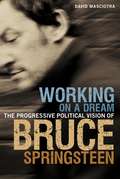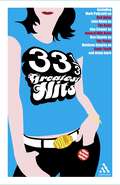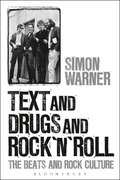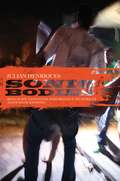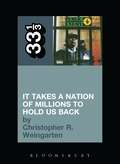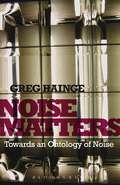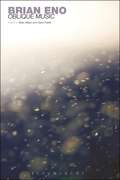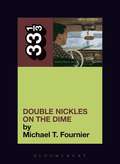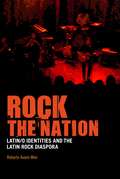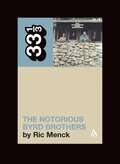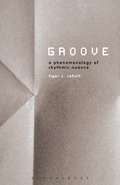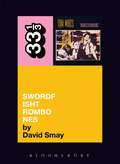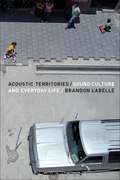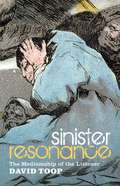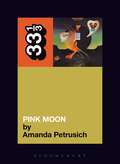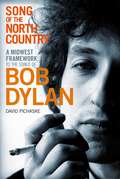- Table View
- List View
Working on a Dream: The Progressive Political Vision of Bruce Springsteen
by David MasciotraFor almost four decades, Bruce Springsteen's music has directly inspired, influenced, and uplifted millions of devoted fans, who hold a special place in their hearts and minds for his work. Springsteen's rise to the top of American music coincided with the triumph of American conservatism, and the veneration of marketplace values above democratic principles and humanistic priorities. Springsteen has consistently summoned his creative power and artistic vision to indict these political developments and demand the cultivation of a more compassionate and progressive society. And yet his often harsh critique of the status quo and radical ideas for reform have either been ignored or misunderstood, as a result of his "All American" image and his narrative storytelling style. On nearly every major issue-poverty, racism, urban decay, war, and peace- Springsteen's music has offered a unique vision for moving forward with the agenda of creating the "country we carry in our hearts"-as he called it in an op-ed for the New York Times. Filled with provocative analysis of Springsteen's best known hits and his most obscure songs, comparisons to other important works of American culture-ranging from The Sopranos to Edward Hopper-and a wealth of information about the last fifty years of American politics, culture, and society, Working On a Dream is a powerful and engaging study of this songwriter and performer's art.David Masciotra shows how Springsteen's music darkly comments on the increased isolation of Americans, and calls for a return to community living and values, based on compassion, empathy, and tolerance. He illustrates how Springsteen has forced listeners to wrestle with the facts of rising poverty rates in the world's richest nation, of wars with questionable justification, and of the continued mistreatment of racial minorities, arguing that Springsteen does this by emphasizing the suffering that everyday people - usually ignored in mainline political discussions - endure on a daily basis.By using Springsteen's life and music to shine a light on the dark recesses of America's most important political and social trials and conflicts- race, religion, and working class hardship-Working on a Dream connects readers with the power, purpose, and promise of Springsteen's extraordinary and enduring music.
33 1/3 Greatest Hits, Volume 2 (33 1/3)
by David BarkerThe second compendium of extracts from Continuum's acclaimed and successful 33 1/3 series, Volume 2 features 20 sharp, savvy and very different writers' takes on albums by Neutral Milk Hotel, Sonic Youth, My Bloody Valentine, David Bowie, the Pixies, the Beastie Boys, Nirvana, R.E.M, the Band and many more. A perfect gift for the music lover in your life!
Text and Drugs and Rock 'n' Roll: The Beats and Rock Culture
by Simon WarnerText and Drugs and Rock'n'Roll explores the interaction between two of the most powerful socio-cultural movements in the post-war years - the literary forces of the Beat Generation and the musical energies of rock and its attendant culture.Simon Warner examines the interweaving strands, seeded by the poet/novelists Jack Kerouac, Allen Ginsberg, William Burroughs and others in the 1940s and 1950s, and cultivated by most of the major rock figures who emerged after 1960 - Bob Dylan, the Beatles, Bowie, the Clash and Kurt Cobain, to name just a few.This fascinating cultural history delves into a wide range of issues: Was rock culture the natural heir to the activities of the Beats? Were the hippies the Beats of the 1960s? What attitude did the Beat writers have towards musical forms and particularly rock music? How did literary works shape the consciousness of leading rock music-makers and their followers? Why did Beat literature retain its cultural potency with later rock musicians who rejected hippie values? How did rock musicians use the material of Beat literature in their own work? How did Beat figures become embroiled in the process of rock creativity? These questions are addressed through a number of approaches - the influence of drugs, the relevance of politics, the effect of religious and spiritual pursuits, the rise of the counter-culture, the issue of sub-cultures and their construction, and so on. The result is a highly readable history of the innumerable links between two of the most revolutionary artistic movements of the last 60 years.
Television's Marquee Moon (33 1/3)
by Bryan WatermanA thoroughly researched study of the origins of the New York City punk scene, focusing on Television and their extraordinary debut record.
Rancid Aphrodisiac: Subjectivity, Desire, and Rock 'n' Roll
by Mickey ValleeIt has been sixty years since Rock 'n' Roll exploded into the mainstream, yet we remain limited in our understanding of how its bawdy excesses absorbed into the annals of mass popularity in such a short amount of time. Mickey Vallee asks: what if the Rock 'n' Roll eruption was nothing less than postwar consumer capitalism at its very best, precisely because it was taken as its very worst? Vallee explores the emergence of Rock 'n' Roll's from an entirely new theoretical disposition in order to answer this question, drawing mainly from Lacanian cultural psychoanalysis to reveal that Rock 'n' Roll was far more conformist than we are generally led to believe; namely, that it was conformist with emerging liberal principles of freedom from the tyranny of the state. Vallee supports this proposition with detailed analyses of familiar (and not-so-familiar) characters and texts in Rock 'n' Roll to suggest that the disruption of our symbolic economy was symptomatic of a new cultural logic of economic freedom. While not denying Rock 'n' Roll's role in the pre-civil rights movement, Vallee refuses the possibility to deny that Rock 'n' Roll's symbolic efficacy ultimately coordinated a neoliberal foundation to the ideology of individualism in its rhythm, instrumentation, lyrics, and vocals, where its power was at its most effective and affective.
Sonic Bodies: Reggae Sound Systems, Performance Techniques, and Ways of Knowing
by Julian HenriquesThe reggae sound system has exerted a major influence on music and popular culture. Out on the streets of inner city Kingston, Jamaica, every night, sound systems stage dancehall sessions for the crowd to share the immediate, intensive and immersive visceral pleasures of sonic dominance. Sonic Bodies concentrates on the skilled performance of the crewmembers responsible for this signature sound of Jamaican music: the audio engineers designing, building and fine-tuning the hugely powerful "sets" of equipment; the selectors choosing the music tracks to play; and MCs(DJs) on the mic hyping up the crowd.Julian Henriques proposes that these dancehall "vibes" are taken literally as the periodic motion of vibrations. He offers an analysis of how a sound system operates - at auditory, corporeal and sociocultural frequencies. Sonic Bodies formulates a fascinating critique of visual dominance and the dualities inherent in ideas of image, text or discourse. This innovative book questions the assumptions that reason resides only in a disembodied mind, that communication is an exchange of information, and that meaning is only ever representation.
Public Enemy's It Takes a Nation of Millions to Hold Us Back (33 1/3)
by Christopher R. WeingartenChristopher R. Weingarten provides a thrilling account of how the Bomb Squad produced such a singular-sounding record: engineering, sampling, scratching, constructing, deconstructing, reconstructing - even occasionally stompingon vinyl that sounded too clean. Using production techniques that have never been duplicated, the Bomb Squad plunderedand reconfigured their own compositions to make frenetic splatter collages; they played samples by hand together in aroom like a rock band to create a "not quite right" tension; they hand-picked their samples from only the ugliest squawks and sirens.Weingarten treats the samples used on Nation Of Millions as molecules of a greater whole, slivers of music that retain their own secret histories and folk traditions. Can the essence of a hip-hop record be found in the motives, emotions and energies of the artists it samples? Is it likely that something an artist intended 20 years ago would re-emerge anew? This is a compelling and thoroughly researched investigation that tells the story of one of hip-hop's landmark albums.
Noise Matters: Towards an Ontology of Noise
by Greg HaingeEveryone knows what noise is. Or do they? Can we in fact say that one man's noise is another teenager's music? Is noise in fact only an auditory phenomenon or does it extend far beyond this realm? If our common definitions of noise are necessarily subjective and noise is not just unpleasant sound, then it merits a closer look (or listen). Greg Hainge sets out to define noise in this way, to find within it a series of operations common across its multiple manifestations that allow us to apprehend it as something other than a highly subjective term that tells us very little. Examining a wide range of texts, including Sartre's novel Nausea and David Lynch's iconic films Eraserhead and Inland Empire, Hainge investigates some of the Twentieth Century's most infamous noisemongers to suggest that they're not that noisy after all; and it finds true noise in some surprising places. The result is a thrilling and illuminating study of sound and culture.
Brian Eno: Oblique Music
by Sean Albiez David PattieOn the back of his published diary Brian Eno describes himself variously as: a mammal, a father, an artist, a celebrity, a pragmatist, a computer-user, an interviewee, and a 'drifting clarifier'. To this list we might add rock star (on the first two Roxy Music albums); the creator of lastingly influential music (Another Green World; Music for Airports); a trusted producer (for Talking Heads, U2, Coldplay and a host of other artists); the maker of large-scale video and installation artworks; a maker of apps and interactive software; and so on. He is one of the most feted and influential musical figures of the past forty years, even though he has described himself on more than one occasion as a non-musician. This volume examines Eno's work as a musician, as a theoretician, as a collaborator, and as a producer. Brian Eno is one of the most influential figures in popular music; an updated examination of his work on this scale is long overdue.
Hymns to the Silence: Inside the Words and Music of Van Morrison
by Peter MillsHymns to the Silence is a thoroughly informed and enlightened study of the art of a pop music maverick that will delight fans the world over. In 1991, Van Morrison said, Music is spiritual, the music business isn't. Peter Mills' groundbreaking book investigates the oppositions and harmonies within the work of Van Morrison, proceeding from this identified starting point. Hymns to the Silence is a detailed investigative study of Morrison as singer, performer, lyricist, musician and writer with particular attention paid throughout to the contradictions and tensions that are central to any understanding of his work as a whole. The book takes several intriguing angles. It looks at Morrison as a writer, specifically as an Irish writer who has recorded musical settings of Yeats poems, collaborated with Seamus Heaney, Paul Durcan and Gerald Dawe, and who regularly drops quotes from James Joyce and Samuel Beckett into his live performances. It looks at him as a singer, at how he uses his voice as an interpretive instrument. And there are chapters on his use of mythology, on his stage performances, and on his continuing fascination with America and its musical forms.
I Shot a Man in Reno: A History of Death by Murder, Suicide, Fire, Flood, Drugs, Disease and General Misadventure, as Related in Popular Song
by Graeme ThomsonAsk the gangsta rap devotee. Ask the grizzled blues fanatic and the bearded folk fan. Ask the goth and the indie kid. Ask and they will all tell you the same thing: death and popular music have forever danced hand-in-hand in funereal waltz time. The pop charts and the majority of radio stations' playlists may conspire to convince anyone listening that the world spins on its axis to the tune of "I love you, you love me" and traditional matters of the heart. The rest of us know that we live in a world where red roses will one day become lilies and that death is the motor that drives the greatest and most exhilarating music of all. "Death music" is not merely a byword for bookish solemnity, or the glorification of murder, drugs and guns. Over the course of the last hundred years it has also been about teenage girls weeping over their high school boyfriend's fatal car wreck; natural disasters sweeping whole communities away; the ever-evolving threat of disease; changing attitudes to old age; exhortations to suicide; the perfect playlist for a funeral; and the thorny question of what happens after the fat lady ceases to sing. Which means that for every "Black Angel's Death Song" there is a "Candle in the Wind," and for every "Cop Killer" there is "The Living Years." Death, like music, is a unifying force. There is something for every taste and inclination, from murderous vengeance to camp sentimentality and everything in between. Drawing upon original and unique interviews with artists such as Mick Jagger, Richard Thompson, Ice-T, Will Oldham and Neil Finn among many others, I Shot a Man In Reno explores how popular music deals with death, and how it documents the changing reality of what death means as one grows older. It's as transfixing as a train wreck, and you won't be able to put it down. as an epilogue, I Shot A Man In Reno presents the reader with the 40 greatest death songs of all time, complete with a brief rationale for each, acting as a primer for the morbidly curious listener.
The Minutemen's Double Nickels on the Dime (33 1/3)
by Michael T. FournierThe story of the Minutemen has been told before (Our Band Could Be Your Life, We Jam Econo), but this book focuses purely on their music - the punk ethic and the remarkable, enduring songs that comprise this, their greatest achievement. Including extensive interviews with Mike Watt and many others close to and inspired by the band, this is a great tribute to a classic piece of American underground music. Included are extensive interviews with Mike Watt, the band's bass player, as well as interviews with several artists, musicians, studio owners, and fanzine writers who have been devoted followers of the band for years.
Rock the Nation: Latin/o Identities and the Latin Rock Diaspora
by Roberto Avant-MierRock the Nation analyzes Latino/a identity through rock 'n' roll music and its deep Latin/o history. By linking rock music to Latinos and to music from Latin America, the author argues that Latin/o music, people, and culture have been central to the development of rock music as a major popular music form, in spite of North American racial logic that marginalizes Latino/as as outsiders, foreigners, and always exotic. According to the author, the Latin/o Rock Diaspora illuminates complex identity issues and interesting paradoxes with regard to identity politics, such as nationalism. Latino/as use rock music for assimilation to mainstream North American culture, while in Latin America, rock music in Spanish is used to resist English and the hegemony of U.S. culture. Meanwhile, singing in English and adopting U.S. popular culture allows youth to resist the hegemonic nationalisms of their own countries. Thus, throughout the Americas, Latino/as utilize rock music for assimilation to mainstream national culture(s), for resistance to the hegemony of dominant culture(s), and for mediating the negotiation of Latino/a identities.
The Byrds' The Notorious Byrd Brothers (33 1/3)
by Ric MenckBy the time Roger McGuinn, David Crosby, Chris Hillman, and Michael Clarke entered the studio to begin work on this album, they were basically falling apart at the seams. "Ladyfriend", a song written by Crosby, had just failed miserably as a chart single despite the fact that he lobbied hard to get it released. This - coupled with the fact that he made what the rest of the band considered an embarrassing political speech onstage during their set at the Monterey Pop Festival, and then sat in with rivals the Buffalo Springfield the following day - pushed McGuinn and Hillman in particular to the limits of their patience. Then, for the Notorious sessions, Crosby presented a song called "Triad", written about a threesome, and although McGuinn and Hillman reluctantly agreed to record it, they later decided to place a less controversial Goffin & King pop number called "Goin' Back" on the album instead. Crosby declared the song banal and refused to sing on it. A few too many studio flare-ups later, McGuinn and Hillman finally screeched up into the Hollywood Hills in their Jaguars and fired Crosby on the spot. Also brooding during this period was drummer Michael Clarke, who had always borne the brunt of the other band members' rage while recording. He was by far the least accomplished member of the band musically, and when they suggested bringing in a studio drummer to embellish some tracks (Jim Gordon, later of Derek & the Dominos fame), he finally declared he'd had enough and moved to Hawaii to get away from the music scene altogether. So, McGuinn and Hillman were left to cobble together an album with the help of producer Gary Usher (known for his work with Brian Wilson, the Millenium, Sagittarius and many others). The fact that it turned out to be one of the defining albums of the 60s psychedelic pop experience was either a sheer stroke of luck, or a testament to McGuinn and Hillman's determination to prove that they didn't need Crosby's help to construct their masterpiece.
Groove: A Phenomenology of Rhythmic Nuance
by Tiger C. RoholtWritten by an experienced drummer and philosopher, Groove is a vivid and exciting study of one of music's most central and relatively unexplored aspects. Tiger C. Roholt explains why grooves, which are forged in music's rhythmic nuances, remain hidden to some listeners. He argues that grooves are not graspable through the intellect nor through mere listening; rather, grooves are disclosed through our bodily engagement with music. We grasp a groove bodily by moving with music's pulsations. By invoking the French philosopher Maurice Merleau-Ponty's notion of "motor intentionality," Roholt shows that the "feel" of a groove, and the understanding of it, are two sides of a coin: to "get" a groove just is to comprehend it bodily and to feel that embodied comprehension.
Tom Waits' Swordfishtrombones (33 1/3)
by David SmayTwo entwined narratives run through the creation of Swordfishtrombones and form the backbone of this book. As the 1970s ended, Waits felt increasingly constrained and trapped by his persona and career. Bitter and desperately unhappy, he moved to New York in 1979 to change his life. It wasn't working. But at his low point, he got the phone call that changed everything: Francis Ford Coppola tapped Tom to write the score for One From the Heart. Waits moved back to Los Angeles to work at Zoetrope's Hollywood studio for the next 18 months. He cleaned up, disciplined himself as a songwriter and musician, collaborated closely with Coppola, and met a script analyst named Kathleen Brennan - his "only true love".  They married within 2 months at the Always and Forever Yours Wedding Chapel at 2am. Swordfishtrombones was the first thing Waits recorded after his marriage, and it was at Kathleen's urging that he made a record that conceded exactly nothing to his record label, or the critics, or his fans. There aren't many love stories where the happy ending sounds like a paint can tumbling in an empty cement mixer. Kathleen Brennan was sorely disappointed by Tom's record collection. She forced him out of his comfortable jazzbo pocket to take in foreign film scores, German theatre, and Asian percussion. These two stories of a man creating that elusive American second act, and also finding the perfect collaborator in his wife give this book a natural forward drive.
Guns N' Roses' Use Your Illusion I and II (33 1/3)
by Eric WeisbardIt was the season of the blockbuster. Between August 12 and November 26 1991, a whole slew of acts released albums that were supposed to sell millions of copies in the run-up to Christmas. Metallica, Michael Jackson, Pearl Jam, Nirvana, Garth Brooks, MC Hammer, and U2 - all were competing for the attention of the record-buying public at the same time. But perhaps the most attention-seeking act of all was Guns N Roses. Their albums Use Your Illusion 1 and 2, released on the same day, were both 75-minute sprawlers with practically the same cover design - an act of colossal arrogance.  On one level, it worked. The albums claimed the top two chart positions, and ultimately sold 7 million copies each in the US alone. On another level, it was a disaster. This was an album that Axl Rose has been unable to follow up in fifteen years. It signaled the end of Guns N Roses, of heavy metal on the Sunset Strip, and the entire 1980s model of blockbuster pop/rock promotion. Use Your Illusion marked the end of rock as mass culture. In this book, Eric Weisbard shows how the album has matured into a work whose baroque excesses now have something to teach us about pop and the platforms it raises and lowers, about a man who suddenly found himself praised to the firmament for every character trait that had hitherto marked him as an irredeemable loser. Â
Acoustic Territories: Sound Culture and Everyday Life
by Brandon LaBelleAcoustic Territories: Sound Culture and Everyday Life offers an expansive reading of auditory life. It provides a careful consideration of the performative dynamics inherent to sound culture and acts of listening, and discusses how auditory studies may illuminate understandings of contemporary society. Combining research on urbanism, popular culture and auditory issues, Acoustic Territories opens up multiple perspectives - it challenges debates surrounding noise pollution and charts an "acoustic politics of space" by unfolding auditory experience as located within larger cultural histories and related ideologies.Brandon LaBelle traces auditory life through a topographic structure: beginning with underground territories, through to the home as a site, and then further, to streets and neighborhoods, and finally to the sky itself. This structure follows sound as it appears in specific auditory designs, as it is mobilized within various cultural projects, and queries how it comes to circulate through everyday life as a medium for social transformation. Acoustic Territories uncovers the embedded tensions and potentiality inherent to sound as it exists in the everyday spaces around us.
In the Blink of an Ear: Toward a Non-Cochlear Sonic Art
by Seth Kim-CohenAn ear-opening reassessment of sonic art from World War II to the present Marcel Duchamp famously championed a "non-retinal" visual art, rejecting judgments of taste and beauty. In the Blink of an Ear is the first book to ask why the sonic arts did not experience a parallel turn toward a non-cochlear sonic art, imagined as both a response and a complement to Duchamp's conceptualism. Rather than treat sound art as an artistic practice unto itself-or as the unwanted child of music-artist and theorist Seth Kim-Cohen relates the post-War sonic arts to contemporaneous movements in the gallery arts. Applying key ideas from poststructuralism, deconstruction, and art history, In the Blink of an Ear suggests that the sonic arts have been subject to the same cultural pressures that have shaped minimalism, conceptualism, appropriation, and relational aesthetics. Sonic practice and theory have downplayed - or, in many cases, completely rejected - the de-formalization of the artwork and its simultaneous animation in the conceptual realm. Starting in 1948, the simultaneous examples of John Cage and Pierre Schaeffer initiated a sonic theory-in-practice, fusing clement Greenberg's media-specificity with a phenomenological emphasis on perception. Subsequently, the "sound-in-itself" tendency has become the dominant paradigm for the production and reception of sound art. Engaged with critical texts by Jacques Derrida, Rosalind Krauss, Friedrich Kittler, Jean François Lyotard, and Jacques Attali, among others, Seth Kim-Cohen convincingly argues for a reassessment of the short history of sound art, rejecting sound-in-itself in favor of a reading of sound's expanded situation and its uncontainable textuality. At the same time, this important book establishes the principles for a nascent non-cochlear sonic practice, embracing the inevitable interaction of sound with the social, the linguistic, the philosophical, the political, and the technological. Artists discussed include:Â George BrechtJohn CageJanet CardiffMarcel Duchamp Bob DylanValie ExportLuc FerrariJarrod FowlerJacob KirkegaardAlvin LucierRobert MorrisMuddy WatersJohn Oswald Marina Rosenfeld Pierre Schaeffer Stephen Vitiello La Monte Young
Portishead's Dummy (33 1/3)
by Rj WheatonAn album which distilled a genre from the musical, cultural, and social ether, Portishead's Dummy was such a complete artistic achievement that its ubiquitous successes threatened to exhaust its own potential. RJ Wheaton offers an impressionistic investigation of Dummy that imitates the cumulative structure of the album itself, piecing together interviews, impressions of time and place, cultural criticism, and a thorough exploration of the music itself. The approach focuses as much on the reception and response that Dummy engendered as it does on the original production of the album. How is that so many people have, collectively, made a quintessential headphone album into a nightclub album? How have they made the product of a niche local scene into an international success? This is the story of how an innovative, experimental album became the iconic sound for the better part of a decade; and an aesthetic template for the experience of music in the digital age.
Richard and Linda Thompson's Shoot Out the Lights (33 1/3)
by Hayden ChildsIn the fall of 1980 Richard and Linda Thompson (of Fairport Convention fame) had recently been dumped from their record label and were on the verge of divorce. Somehow they overcame these miserable circumstances and managed to make an album considered by many to be a masterpiece.Shoot Out The Lights puts the album-from the personal history driving the songs, to the recording difficulties they encountered and the subsequent fall-out-in context. This is a brilliant, emotional book about a brilliant, emotional album.
Kraftwerk: Music Non-Stop
by Sean Albiez David PattieWhen they were creating and releasing their most influential albums in the mid to late 1970s, Kraftwerk were far from the musical mainstream - and yet it is impossible now to imagine the history of popular music without them. Today, Kraftwerk are considered to be an essential part of pop's DNA, alongside artists like the Beatles, the Velvet Underground, and Little Richard.Kraftwerk's immediate influence might have been on a generation of synth-based bands (Orchestral Manoeuvres in the Dark, the Human League, Depeche Mode, Yello, et al), but their influence on the emerging dance culture in urban America has proved longer lasting and more decisive. This collection of original essays looks at Kraftwerk - their legacy and influence - from a variety of angles, and demonstrates persuasively and coherently that however you choose to define their art, it's impossible to underestimate the ways in which it predicted and shaped the future.
Sinister Resonance: The Mediumship of the Listener
by David ToopSinister Resonance begins with the premise that sound is a haunting, a ghost, a presence whose location is ambiguous and whose existence is transitory. The intangibility of sound is uncanny – a phenomenal presence in the head, at its point of source and all around. The close listener is like a medium who draws out substance from that which is not entirely there.The history of listening must be constructed from the narratives of myth and fiction, 'silent' arts such as painting, the resonance of architecture, auditory artefacts and nature. In such contexts, sound often functions as a metaphor for mystical revelation, forbidden desires, formlessness, the unknown, and the unconscious. As if reading a map of hitherto unexplored territory, Sinister Resonance deciphers sounds and silences buried within the ghostly horrors of Arthur Machen, Shirley Jackson, Charles Dickens, M.R. James and Edgar Allen Poe, Dutch genre painting from Rembrandt to Vermeer, artists as diverse as Francis Bacon and Juan Munoz, and the writing of many modernist authors including Virginia Woolf, Samuel Beckett, and James Joyce.
Nick Drake's Pink Moon (33 1/3)
by Amanda PetrusichPink Moon explores how Nick Drake's third and final album has puttered and purred its way into a new millennium. Features interviews with producer Joe Boyd, string arranger Robert Kirby, and even the marketing team behind the VW Cabrio commercial that launched the album to platinum status more than thirty years after its release.
Song of the North Country: A Midwest Framework to the Songs of Bob Dylan
by David PichaskeA remarkably fresh piece of Dylan scholarship, focusing on the profound impact that his Midwestern roots have had on his songs, politics, and prophetic character.
